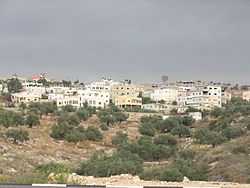Deir Qaddis
| Deir Qaddis | |
|---|---|
| Other transcription(s) | |
| • Arabic | دير قديس |
| • Also spelled |
Deir Qiddis (official) Dayr Qaddis (unofficial) |
 | |
 Deir Qaddis | |
| Coordinates: 31°56′58″N 35°02′44″E / 31.94944°N 35.04556°ECoordinates: 31°56′58″N 35°02′44″E / 31.94944°N 35.04556°E | |
| Governorate | Ramallah & al-Bireh |
| Government | |
| • Type | Village Council |
| • Head of Municipality | Fares Ibrahim |
| Area | |
| • Jurisdiction | 8,207 dunams (8.2 km2 or 3.2 sq mi) |
| Population (2007) | |
| • Jurisdiction | 1,942 |
| Name meaning | "Monastery of the Saint"[1] |
Deir Qaddis (Arabic: دير قديس) is a Palestinian town in the Ramallah and al-Bireh Governorate in the central West Bank, located sixteen kilometers west of Ramallah.[2] According to the Palestinian Central Bureau of Statistics, the town had a population of approximately 1,942 inhabitants in 2007.[3] The town consists of 8,207 dunams, of which 438 dunams are classified as built-up area. As a result of the 1995 Interim Agreement on the West Bank and the Gaza Strip, 8.9% of Deir Qaddis' land was transferred to the Palestinian National Authority, but Israel still retains full control of 91.1% of the town.[2]
History
Deir Qaddis means the "Monastery of the Saint".[1] French explorer Victor Guérin found in the Kharbet (=ruin) Deir Kaddis remains of houses built with large blocks and several cisterns dug into the rock,[4] while SWP (1882) notes a ruined monastery and cave near by the village, and that the name of the village indicates that a convent once existed here.[5]
Deir Qaddis appeared in the 1596 Ottoman tax registers as Dayr Qiddis in the Nahiya of Ramlah of the Liwa of Gazza. It had a population of 11 households, all Muslim, and paid taxes on wheat, barley, summer crops, olive- and fruit trees, goats and beehives, and a press for olives or grapes.[6]
In 1863 Guérin estimated that Deir Kaddis had about 350 inhabitants.[4] In The Survey of Western Palestine (1882), Deir el Kuddis was described as a "small hamlet on a high hill-top, with gardens to the north [..] There is a well on the east."[5]
In the 1922 census of Palestine, conducted by the British Mandate authorities, Dair Qaddis had a population of 299, all Muslims,[7] increasing in the 1931 census to a population of 368, still all Muslim, in 82 houses.[8]
In 1945 the population of Deir Qaddis was 440 Arabs, with 8,224 dunams of land, according to an official land and population survey.[9] 1,815 dunams were used for plantations and irrigable land, 1,069 dunams for cereals,[10] while 8 dunams were built-up (urban) land.[11]
Present
After the 1948 Arab-Israeli War, Deir Qaddis was ruled by the Hashemites of Jordan. Deir Qaddis came under Israeli occupation along with the rest of the West Bank after the 1967 Six-Day War.
The town, today, contains a mosque, three schools (two primary and one secondary), two medical clinics and a sports club. The town's prominent families are Husain,Qattosa,Nasser, Abu Zeid, Hamada, Awadh, Abu Laban and Kreish.[12]
References
- ↑ 1.0 1.1 Palmer, 1881, p. 228
- ↑ 2.0 2.1 The Case of Deir Qiddis village Applied Research Institute - Jerusalem 10 November 2007.
- ↑ 2007 PCBS Census. Palestinian Central Bureau of Statistics. p.114.
- ↑ 4.0 4.1 Guérin, 1875, p. 85
- ↑ 5.0 5.1 Conder and Kitchener, 1882, p. 297
- ↑ Hütteroth and Abdulfattah, 1977, p. 154.
- ↑ Barron, 1923, Table VII, Division Jaffa, Sub-district of Ramleh
- ↑ Mills, 1932, p. 19
- ↑ Government of Palestine, Department of Statistics. Village Statistics, April, 1945. Quoted in S. Hadawi, Village Statistics, 1945. PLO Research Center, 1970, p. 66
- ↑ Government of Palestine, Department of Statistics. Village Statistics, April, 1945. Quoted in S. Hadawi, Village Statistics, 1945. PLO Research Center, 1970, p. 114
- ↑ Government of Palestine, Department of Statistics. Village Statistics, April, 1945. Quoted in S. Hadawi, Village Statistics, 1945. PLO Research Center, 1970, p. 164
- ↑ History of Dayr Qaddis Palestine Remembered. (Arabic)
Bibliography
| Wikimedia Commons has media related to Deir Qaddis. |
- Barron, J. B., ed. (1923). Palestine: Report and General Abstracts of the Census of 1922. Government of Palestine.
- Conder, Claude Reignier; Kitchener, H. H. (1882). The Survey of Western Palestine: Memoirs of the Topography, Orography, Hydrography, and Archaeology 2. London: Committee of the Palestine Exploration Fund.
- Guérin, Victor (1875). Description Géographique Historique et Archéologique de la Palestine (in French). 2: Samarie, pt. 2. Paris: L'Imprimerie Nationale.
- Hadawi, Sami (1970). Village Statistics of 1945: A Classification of Land and Area ownership in Palestine. Palestine Liberation Organization Research Center.
- Hütteroth, Wolf-Dieter; Abdulfattah, Kamal (1977). Historical Geography of Palestine, Transjordan and Southern Syria in the Late 16th Century. Erlanger Geographische Arbeiten, Sonderband 5. Erlangen, Germany: Vorstand der Fränkischen Geographischen Gesellschaft. ISBN 3-920405-41-2.
- E. Mills, ed. (1932). Census of Palestine 1931. Population of Villages, Towns and Administrative Areas. Jerusalem: Government of Palestine.
- Palmer, E. H. (1881). The Survey of Western Palestine: Arabic and English Name Lists Collected During the Survey by Lieutenants Conder and Kitchener, R. E. Transliterated and Explained by E.H. Palmer. Committee of the Palestine Exploration Fund.
- Socin, A. (1879). "Alphabetisches Verzeichniss von Ortschaften des Paschalik Jerusalem". Zeitschrift des Deutschen Palästina-Vereins 2: 135–163. (p. 152 )
External links
- Deir Qaddis Factsheet, ARIJ
- Deir Qaddis profile, ARIJ
- Deir Qaddis areal photo, ARIJ
- The Expansion of Kiryat Sefer Settlement on the Land of Dier 27, February, 1997, ARIJ
- The Israeli Occupation Milling of a Road Designated for "Military Purposes" Deir Qaddis – Ramallah Governorate 01, June, 2011, ARIJ
- “Israeli Piracy During the Daylight” The Israeli Bulldozers Started to Razing Lands in Deir Qiddis in order to loot more than 100 dunums of Deir Qiddis lands southwest of Ramallah 02, June, 2011, ARIJ
- Welcome To Dayr Qaddis
